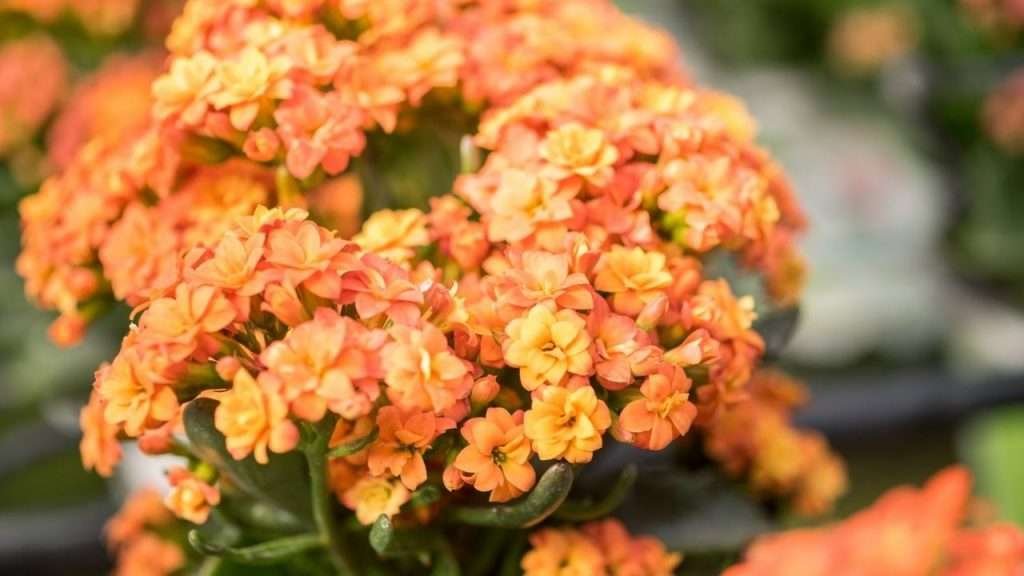Flaming Katy, also called Christmas Kalanchoe or Florist Kalanchoe, is a succulent plant that springs small tube-like flowers in a flower head. Flowers display various colors upon blooming like orange, yellow, red, and purple. They also have a fleshy appearance and texture similar to other succulents.
Their journey as a houseplant began when they were grown as gift plants. Many people saw that the plant had become uninteresting when they were not blooming and discarded them as soon as they died. This initial sentiment changed when they recognized that the plant blooms several times and at any time of the year.
Genus Name: Kalanchoe blossfeldiana
Plant Type: perennial, indoor
Height: 1.5 ft
Breath: 0.6 ft wide
Foliage color: orange, yellow, red, and purple
Especially known for toughness, low maintenance
Propagation method: stem cuttings/leaf cuttings
Caring for Your Flaming Katy

From bright light to well-draining soils and moderate temperatures, here are some of the essential requirements you need to note when taking care of a Flaming Katy.
Lighting
Flaming Katy requires a placement on a nice windowsill to receive bright sunlight that is not too direct, especially during summertime. Lower lighting can still promote green foliage, and the plants can still bloom. Best to place it at an east- or west-facing window.
Soil
Use a well-draining potting soil with 60 percent peat moss and 40% percent perlite. Choose a container that is one or two inches bigger than the plant and keep it in a sunny area. Terracotta pots work well with succulents because they don’t conserve as much moisture as other pot materials. You can use a standard liquid fertilizer once a month from spring until summer’s end.
Water Temperature
Anything between 51°F (10°C) and 72°F (22°C) is the optimal watering temperature for a Kalanchoe – and an occasional fluctuating beyond these limits is permissible. The hardline, however, is avoiding frost. Even the slightest waft of frost can damage the plant.
You can avoid frost damage by being attentive. While a forgetful gardener would get away with inadequately watering the Flaming Katy, the mindful tenderer will wet the soil lavishly anytime it’s dry. Water sparingly in cold weather months. Just a few amounts of water are needed during long stretches of days.
Pruning and Propagating If Needed

Since they bloom several times a year, prune them the moment existing flowers are weak or dead to promote the growth of new buds and refreshed flowering.
Flaming Katy is propagated by cutting:
Cut no less than a 3-inch cutting through the vegetative stem. Position the cutting in an empty pot for 2 to 3 days to allow a callus to develop over the nicked flesh of the stem. The callus prevents the cutting from decomposing within the propagating medium.
Mix equal proportions of sand, peat, and perlite to make a potent growing environment for the Katy cuttings. Place the growing medium in a sterile pot and water gently. Pots that are 3 to 4 inches wide hold a single cutting.
Create a hollow in the growing medium and place the callused cutting into the hollow. Gather the soil around the cutting firmly to keep the plant upright. Direct the pot to a sunny area with a mean temperature of about 70°F (21°C).
If you have inserted multiple cuttings into the medium, transplant the new Flaming Katy plants into individual growing pots when the roots have grown about an inch long. Place the new Flaming Katy in any desired spot in your house as soon as you observe new growth.
How to Prepare Flaming Katy for Winter
Winterizing your Kalanchoe involves keeping it above ten 50°F (10°C). Drafty windows are sure to cause problems as turbulent winds cause a drop in temperature. Extended exposure to cold can be debilitating for Flaming Katy.
Water once every two to three weeks during winter.
Common Pests and Disease
Flaming Katy is susceptible to powdery mildew, mealybugs, and aphids.
Mildew is a white powdery coating on the leaves and stem. It can be contagious if not identified and treated early.
Mealybugs leave white foggy patches near the leaf axis and underneath the leaves. Root mealybugs are responsible for plant wilting. Gently remove the plant out of its pot and check the root for damage inflicting pests. Treat any infection with utmost urgency to prevent them from spreading to other decorative plants. If the plant is badly infested, then it’s time to get a new one.
Final Thoughts
Flaming Katy’s gorgeous, evergreen succulent decorative plant fits any homeowner’s decor blueprint. Remember to pot the plant in a container with good drainage via drainage outlets or thick rock underneath the soil. Don’t allow pets to ingest it as Flaming Katy can be toxic.
Life is Better When You Garden™
FAQ
How to fix a leggy flaming Katy?
To fix a leggy Katy plant, you have to think about what caused the problem in the first place. In some cases, it’s a lack of sunlight. If you’re growing your plant indoors, you may need to move it to a sunny window.
In other cases, it’s not enough water. If you’re watering your Katy plant correctly, however, then you may need to repot it and transplant it into a new pot. A Katy plant likes to have extra room to grow, so it’s common to repot right after you’ve bought the plant or when the plant is getting too big for the pot.
Can you propagate the flaming Katy Plant?
Yes, you can. The best way to propagate a flaming Katy plant is by rooting the cuttings. In order to do this, you’ll need to take a cutting of your Katy plant, making sure that the leaf you’re going to root is at least three inches long.
It is important that you take cuttings in early spring through to late fall because this is when the plants are at their strongest.
Is flaming Katy poisonous to dogs?
Despite being a common household plant, the flaming Katy is actually a pretty toxic plant to dogs. The leaves, stems, and roots are all dangerous to dogs and can cause severe problems like vomiting, diarrhea, and even seizures. Fruits that the Katy produces are also poisonous, but only in large doses.
Is flaming Katy poisonous to cats?
The flaming Katy is toxic to cats, so it’s best to keep it away from your cats. The poisonous substance in flaming Katy cardiac glycoside can cause severe heart problems for your cats. If you suspect that your cat has chewed or eaten the plant, you should contact your vet immediately.
Is flaming Katy poisonous to rabbits?
One of the most common questions we hear about Katy plants is if they are poisonous to rabbits. It turns out that they are and they can actually be toxic to other animals as well.
This means that it is best to keep your Katy plant away from your pets as much as possible.
Is flaming Katy poisonous to humans?
Flaming Katy is not poisonous to humans. While flaming Katy is poisonous to animals, humans are not in danger. It’s poisonous to animals because of the sap, so if you’re growing your Katy plant outdoors and an animal eats it, they will most likely get sick. However, the sap is not poisonous to humans.
Why are my flaming Katy leaves turning yellow?
Overwatering and under watering are usually the reason that a Katy plant’s leaves are turning yellow. While Katy plants can withstand being a little too moist, it’s bad for the plant to have a lot of water in the soil. This is because the leaves will absorb the extra liquid and eventually turn yellow.
There are other causes, however, like plant disease or low sunlight. The majority of the time, yellow leaf foliage is due to a potassium deficiency. You can add some kind of potassium source, such as bone meal, perlite, potash, or blood meal when we water our plants.
Can I prune flaming Katy?
Yes, you can prune a flaming Katy plant. To do this, you’ll need to cut off the oldest, dried-up leaves in order to promote healthy new growth. You’ll also want to prune back the main stem of your Katy plant so that it can focus on other growth. Prune your Katy plant in early spring or fall.
Other Great Posts:






